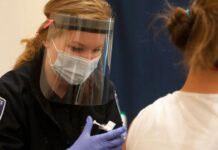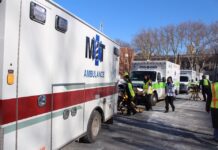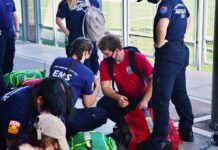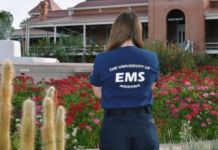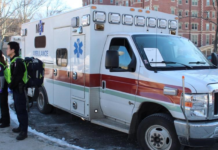Abstract
Background: Law enforcement canines (LEK9s) are increasingly present for security and surveillance at marathons and other mass gathering events (MGEs). Dependent on state laws, non-veterinary collegiate-based emergency medical services (CBEMS) providers may be able to provide emergency care to LEK9s in the event of illness or injury. In preparation for the 2018 Illinois Marathon, we delivered a one-hour training course on LEK9 emergency care to providers of Illini EMS (IEMS) at the University of Illinois at Urbana-Champaign. The objective of this report is to describe the development, implementation, and evaluation of the training course. Case Report: At the request of IEMS, the training course was developed through a collaboration between a representative of IEMS, two emergency physicians, and three veterinary specialists. The first 30 minutes of the course included a presentation with information on triage and assessment in the field, blast injuries, opioid/toxin exposure, heat-related illness, artificial ventilation, and cardiopulmonary-resuscitation (CPR). The remainder of the course included hands-on training in which providers practiced palpating a pulse, administering artificial ventilations, and providing CPR on a K9 manikin. The course was evaluated via a post-course survey to identify areas for course improvement. Conclusions: To our knowledge, this is the first publication describing a training course for CBEMS providers in the identification and management of medical emergencies in LEK9s. Planned improvements for future courses include incorporation of multimedia, live animal training, and additional hands-on training with critical care and/or emergency veterinarians. CBEMS organizations may consider adapting the course in preparation for MGEs in consultation with veterinary specialists.
Introduction
Historically, the finish line of a marathon has been a place of celebration and triumph for both the runners and spectators. Celebration transformed into tragedy when two homemade bombs detonated at the finish line of the Boston Marathon on April 15, 2013. The terrorist act killed 3 people and injured an additional 281 runners and spectators.1 As a result of the mass casualty incident (MCI), there has been an increased focus on security and surveillance at marathons and other mass gathering events (MGEs), traditionally defined as events with 1,000 or more persons in a specific location for a specified period of time.2 In particular, law enforcement canines (LEK9s) are now frequently included on security teams at MGEs. LEK9s have numerous assignments, including explosives and narcotics detection, patrol, tracking, apprehension and arrest, and search and rescue. Their versatility stems from their keen sense of smell, ability to navigate inaccessible areas, and ability to search a given area approximately 50 times faster than a human.3-7
LEK9s working at marathon or other MGEs may suffer from an acute illness or injury, particularly if an MCI occurs due to a violent attack (eg, bombing, active shooter incident) or a natural cause (eg, extreme weather, structural collapse). At select, high-profile events and exercises, veterinary medical professionals may be present on-site to provide immediate treatment. For example, National Veterinary Response Teams are deployed for National Special Security Events such as political conventions, presidential inaugurations, and the United Nations General Assembly. While increasing the presence of veterinary medical professionals at MGEs is worthy of attention, professional veterinary support is not routinely available at most MGEs with LEK9s on site.
Non-veterinary medical staff may be able to provide basic emergency care to LEK9s depending on state laws and regulations.8 On-site medical staff at MGEs might include emergency medical services (EMS) providers, emergency physicians, advanced practice providers, nurses, and physical therapists.9 Notably, the presence of collegiate- or campus-based EMS (CBEMS) providers at MGEs has been recently described in the literature.10-12 CBEMS providers may be involved in the planning, management, and provision of care at MGEs on university and college campuses10-12; however, CBEMS providers should receive additional training in order to safely and effectively identify and manage medical emergencies in LEK9s. To our knowledge, there are no prior publications describing the training of CBEMS providers in the identification and management of medical emergencies in LEK9s.
Illini EMS (IEMS), a CBEMS organization at the University of Illinois Urbana-Champaign (UIUC), routinely staffs MGEs. In preparation for the 2018 Christie Clinic Illinois Marathon, we delivered a one-hour pilot training course on LEK9 emergency care to IEMS providers. The objective of this report is to describe the development, implementation, and evaluation of the course.
Case Report
Illini EMS at the Illinois Marathon
Illini EMS (IEMS) is a basic life support (BLS), non-transporting, CBEMS organization located at the University of Illinois Urbana-Champaign (UIUC). IEMS serves as an organization within the Illinois Fire Institute and is staffed by volunteer undergraduate students. IEMS volunteers staff the Christie Clinic Illinois Marathon, a United States Track and Field (USTAF)-certified course covering the streets of Urbana-Champaign with approximately 7,000 participants. IEMS student leadership is involved in event preparations, including planning team placement and the number of volunteers needed. At the event, IEMS provides medical care at the finish line at Memorial Stadium on campus and via bicycle throughout the race course. Additional medical staff on-site include: emergency medical technicians (EMTs) from two fire departments, paramedics from two advanced life support (ALS) ambulance companies, emergency department and intensive care unit nurses on the course and at the finish line, and emergency physicians in the field hospital at the finish line in Memorial Stadium. The start/finish line of the marathon is located near a tertiary veterinary referral hospital (University of Illinois College of Veterinary Medicine) with 24-hour emergency and critical care capacity – transport of an affected animal to this facility could be performed if additional treatment was required.
Development and Design of Training
IEMS student leadership requested training on the identification and management of medical emergencies in LEK9s working at the 2018 Illinois Marathon. The IEMS providers reportedly had no prior experience or training in the handling of LEK9 medical emergencies. A panel including a CBEMS representative, two emergency physicians, two board certified veterinary specialists in emergency and critical care, and a board eligible veterinary specialist in anesthesiology evaluated the most likely LEK9 emergency scenarios to occur during the marathon. A training protocol was then created to provide training on recognition and emergency treatment for these conditions, including: heat-related illness, opioid/toxin exposure, blast injury, respiratory distress, and cardiopulmonary arrest (CPA)
The training course was held on the UIUC campus three weeks before the 2018 Christie Clinic Illinois Marathon. The hour-long course was run by two board-certified veterinary specialists in emergency and critical care. Twenty IEMS members attended. The course started with a 30-minute PowerPoint presentation covering a range of topics, including: triage and assessment in the field, opioid/toxin exposure, blast injuries, heat-related illness, identification of CPA, and performance of cardiopulmonary resuscitation (CPR) (Table 1). Images of dogs were provided to attendees detailing physical landmarks for assessment of vital signs. Figures were also provided with examples of dogs in appropriate positions for CPR. In addition, instructions – translated from veterinary CPR guidelines – were provided on positioning of the dog, hand position, depth of compressions, and number of compressions per minute (Table 2).13,14
Table 1. Outline of the Pilot Training Course PowerPoint Presentation
Table 2. Basic life support CPR guidelines for canines13,14
After the presentation, the twenty participants were arranged into two separate groups for hands-on training under direct guidance from board-certified veterinary specialists in emergency and critical care. Each group had a K9 CPR manikin (Rescue Critters® Dog Veterinary Training Manikin; Simi Valley, CA) available for practicing BLS CPR, proper placement of an oxygen face mask, and basket muzzle placement. The participants could ask questions from the veterinary specialists at any time during or immediately after the event.
Evaluation and Improvement
In order to guide future course improvements, an online survey was distributed via email after the training and available for 24 hours. No continuing education credit or other incentives were offered in return for answering the survey. Approval was received from the Institutional Review Board of UIUC. The following questions were included in the post-training survey, to be answered free form by the participants.
- What were your favorite aspects of the training event?
- How would you adjust the length of the event?
- How would you adjust the ratio of lecture to hands-on practice?
- What aspects of the training event could be improved?
Six out of twenty attendees (30%) completed the survey. All six respondents (100%) reported that the hands-on portion was the best part of the training course. Four of six (67%) answered that they would have preferred a higher ratio of hands-on practice to lecture, with two (33%) answering that the time allotted for each was sufficient. In addition, all six respondents (100%) reported wanting a longer training event. Answers received regarding aspects for improvement included requests for more background information on CPR, more information on how to translate the training if there are no canines or manikins available, more time practicing chest compressions, and availability of a concise outline of the PowerPoint to follow along. Anecdotally, the instructors noted that the participants really enjoyed time with the CPR manikin and would have appreciated additional time to practice chest compressions and placement of a face mask.
Based on this feedback, we plan to include additional time for hands-on training with the CPR manikin in the future and to potentially include training with a live dog. The CBEMS organization might also purchase their own canine CPR manikin (cost approximately $300-$1500). The training could be split into two, one-hour sessions in the future, with the option for participants to return for additional training.
Discussion
Legislation of Medical Care for Animals by Non-Veterinarians
Legislation that provides authority and liability protection for the medical treatment and transport of LEK9s and other animals by non-veterinarians, including EMS providers, varies widely from state to state. 8 To date, most states do not permit medical treatment or transport of animals by non-veterinary personnel. Treatment and/or transport may violate a given state’s veterinary practice acts, EMS statutes and protocols, or “Good Samaritan Laws.”8 Working Dog HQ, a veterinarian-led organization dedicated to preventing canine opioid overdoses, maintains a database of relevant legislation (https://workingdoghq.com/legislation-update/). According to the organization, as of February 2019, legislation in Ohio, Colorado, Maryland, Wisconsin, New York, Mississippi, California, and Illinois permits treatment and/or transport of select animals by non-veterinarians in select instances. In Illinois, recent legislation now permits EMS providers to transport an LEK9 injured in the line of duty to a veterinary clinic if no humans require medical care or transport at the same time.
According to Working Dog HQ, additional legislation is under consideration or pending approval in numerous states, including New Jersey, New York, Pennsylvania, Washington, Massachusetts, and South Carolina. The expansion of such legislation throughout the U.S. – coupled with the careful development of treatment and transport protocols – may provide greater access to emergency medical care for the LEK9s who serve and protect us. CBEMS providers should actively follow the development of relevant legislation in their state and consider advocating for the expansion of legislation that protects LEK9s.
Given the current state of affairs, readers should acknowledge that the following recommendations and descriptions are provided for educational purposes only. The information regarding assessment and treatment is designed to be a cursory introduction to the topics. The information is not intended to be a substitute for professional medical advice, diagnosis, or treatment nor comprehensive training under a veterinary professional. The authors are not responsible or liable for any advice, course of treatment, diagnosis, or service. CBEMS providers and leaders should review their state’s laws before providing medical care to a dog, consult with their medical director, and have the name and number for contact veterinarian(s) available. For additional considerations regarding the legalities of first responders treating working dogs please see: “Best Practice Recommendations for Prehospital Veterinary Care of Dogs and Cats.”8
Recommendations for on-campus mass gathering event planning
CBEMS leaders involved in planning for on-campus mass gathering events should communicate with local law enforcement to determine if LEK9s might be present at the event. In the possibility of LEK9 presence, CBEMS leaders should determine applicable laws regarding non-veterinary medical treatment of LEK9s and consider developing a pre-event training similar to that described in this report. In addition, CBEMS leaders should consider coordinating before the event with event managers and public safety personnel to develop plans/policies regarding the need to staff veterinary teams and veterinary hospital transport options.
The type of training described in this report can be adapted by other CBEMS organizations in coordination with local veterinarians who are ideally specialists in emergency and critical care. The venue for the training should allow for projection of a presentation on a screen and should have sufficient room for a large group to work together for hands-on skills practice. A dog CPR manikin can be purchased online by the CBEMS organization with the typical cost ranging from $300 to $1500. Additional funds for a face mask (approximately $30) and bag-valve mask (Ambu bag®; Ambu Emergency Medical, Columbia, MD) (approximately $30) should be included in the budget. Otherwise, the cost for a comparable training is low.
The following considerations are important for collegiate EMS providers to be aware of regarding LEK9 emergencies and should be included in pre-event training on LEK9 emergencies; additional details are available in the referenced materials.
Dog handling and identification of emergencies in LEK9s
All volunteers reported that they had no previous experience handling any dogs in a medical capacity but were willing to learn. The identification and treatment of medical emergencies in LEK9s are often the responsibility of the handler. The handler will know his or her dog well, and together with medical providers, both parties can initiate treatment in the case of an emergency in the field. If medical intervention is needed, the handler and EMS can work together until veterinarian-directed care is available.8 Basic triage and assessment – including the recording of vital signs – can be performed by the medical personnel during initial evaluation of the LEK9 in the field. It is important to note that an injured, conscious working dog may pose a serious health and safety risk to personnel working around them. Appropriate judgment must be used in determining whether a basket muzzle should be placed on the dog prior to treatment or transport, as heat-related illness or respiratory distress could be exacerbated by muzzle placement. It is also important to note that the treatment of a human always supersedes treatment of a canine in situations where both human(s) and canine(s) require immediate medical care.
Blast injuries
Due to the Boston Marathon bombing, blast injury from an explosion is now recognized as a threat to all attendees, including LEK9s, at a marathon or other MGE. Primary injury – due to blast waves – may lead to blunt trauma to the thorax and/or abdomen. Secondary injury – due to flying debris – may lead to penetrating wounds. Tertiary injury – due to an LEK9’s being thrown from the blast – may result in both blunt and penetrating trauma. Quaternary injury – all other injuries – may include crush injuries, burns, asphyxia, or toxic exposure.8 Blast injuries can involve multiple parts of the body simultaneously; however, in dogs, thoracic injury is generally the most common injury associated with blunt trauma.15 Due to the nature of blast injuries, many injuries, including thoracic injuries, require advanced-level care. Nonetheless, LEK9s who have been injured in an explosion would benefit from immediate intervention by non-veterinary EMS personnel in the field.
EMS providers can assess vital signs and implement bleeding control measures for external hemorrhage. If external hemorrhage of a limb is identified on an LEK9, EMS providers may first apply firm, direct pressure using a towel, bandage material, or hemostatic compound.8 Hemostatic compounds have the same mechanism of action in a canine as a human and can be used to manage hemorrhage if readily available.16 A tourniquet may be considered; however, one that is made for a human may be too large for a dog limb. In addition, it is not recommended to remove any penetrating objects or debris from the wound site.8
Opioid exposure
LEK9s may seek out individuals carrying illicit substances, including opioids, that are concealed to the public.17 Given the high rate of opioid misuse and abuse amongst young adults – estimated at 7.3% of all adults ages 18-25 in the United States in 201618 – the possibility that an LEK9 may encounter an opioid must be considered, particularly at events on college and university campuses. Information on the identification and treatment of an accidental opioid exposure in an LEK9 should therefore be included in any pre-MGE training course.
Accidental opioid exposure should be suspected if the presence of opioid drugs is suspected (based on the operational environment) and the dog shows signs of opioid exposure: lethargy, ataxia, pupillary constriction, decreased responsiveness, respiratory depression, and collapse.19 While opioid exposure alone does not warrant the use of naloxone, administration of naloxone should be considered in a dog that develops respiratory depression or respiratory arrest. EMS or dog handlers may have the reversal agent (ie, naloxone) for use in the event of human exposure. Published guidelines for emergency administration of naloxone to an LEK9 in the event of suspected accidental opioid exposure in the field recommend either an intravenous or intraosseous injection at 0.01-0.04 mg/kg20 or an injection intramuscularly at 0.04 mg/kg – 0.16 mg/kg.21 Intranasal administration at 2-4 mg per 25 kg in a dog may also be considered, but there are no published studies directly evaluating the efficacy of intranasal naloxone in dogs.19
Extreme caution should be practiced by any person who may come in contact with the affected LEK9.19 When approaching the scene of a suspected opioid overdose in an LEK9, providers should wear personal protective equipment (PPE) to prevent contact with potent opioids. Mouth-to-snout ventilation should NOT be attempted in these patients as the human may contact potent opioids leading to a human death. The LEK9 can and should be ventilated with a bag-valve mask (eg, Ambu® bag) in situations where respiratory failure is present, as discussed in greater detail below (see Cardiopulmonary Arrest).19
Heat-Related Illness
Marathons run all year long, and temperatures on race day vary depending on the location and time of year. The potential for high temperatures may prompt medical staff to prepare for heat related-illnesses in humans, as high temperatures are associated with high patient loads22,23; however, medical staff should also be aware of the potential for heat-related illness in LEK9s. Body temperature in a working dog may be higher than a companion dog during regular exercise, potentially reaching a rectal temperature of 42.2°C or 108°F, whereas normal rectal temperature is 37.4-39.7°C or 99.4-103°F.24 Performance in the field and vulnerability to heat-related illnesses can depend not only on environmental ambient temperature, but also on the K9’s body condition, the K9’s acclimation to environmental heat, working conditions, availability of potable water, hydration status, and the length and number of rest periods the K9 takes while working.25-27 Dehydration is a common condition in dogs working long work shifts with limited break time in addition to decreased access to potable water – a combination that lays the groundwork for heat stress or heat stroke in the field.28
Signs of heat-related illness include increased respiratory rate and effort, lethargy, unwillingness to work, decreased responsiveness to commands, vomiting, diarrhea, and collapse.8 If signs of heat-related illness are noted, EMS providers should implement cooling measures using a readily available water source, such as a garden hose, while being careful to avoid induction of shivering.8,29 Rapidity of implementing cooling measures is correlated with a positive outcome so immediate cooling is indicated if there is any suspicion of overheating.30 Prompt transport to an available veterinary hospital is also warranted in order to decrease the risk of systemic complications.29
Cardiopulmonary Arrest
The conditions described above – blast injury, toxic/opioid exposure, or heat-related illness – can lead to cardiopulmonary arrest (CPA) in an LEK9, as can other known or unknown conditions. As in humans, starting CPR immediately after CPA may lead to return of spontaneous circulation.31 To our knowledge, there are no peer-reviewed published recommendations for non-veterinary medical personnel on how to perform basic life support in a dog. However, instructions on positioning of the dog, hand position, depth of compressions, and number of compressions per minute may be translated from veterinary CPR guidelines (Table 2).13,14 In addition, the American Red Cross provides basic instructions online for the layperson: https://www.redcross.org/take-a-class/cpr/performing-cpr/pet-cpr.
In cases where an LEK9 arrests in the field, assisted ventilation with a tight-fitting face bag-valve mask would be the most effective way of administering breaths. Proper placement of an oxygen face mask is crucial for effective ventilation in the field as mouth-to-snout method of ventilation is not recommended due to the potential for opioid exposure and risk of canine bites to the human performing the procedure.32
Limitations
Although feedback obtained through the post-training survey has helped guide future training initiatives, limitations must be acknowledged, including: a low response rate and small number of respondents (perhaps due to a lack of incentives for survey completion), a lack of demographic data (age, sex) obtained, and limited information on the survey’s validity and reliability as the survey questions were not piloted prior to distribution. There is a need to further test the efficacy of the training through rigorous assessments of skills and knowledge of attendees.This case report describes a single pilot training session delivered to prepare CBEMS providers for a specific mass gathering event, the 2018 Illinois Marathon. Without modification, this training may not be sufficient to train EMS providers, or other non-veterinary medical staff, to adequately intervene in LEK9 emergencies at other events and in other contexts. Feedback from attendees indicated that the hands-on portion of the training should have been longer. Future trainings should include additional time for hands-on training, potentially supplemented with live animal training and additional instruction on fitting a face mask on a dog. In addition, it may be valuable for participants to watch instructional videos before the training to maximize the amount of time that can be spent with hands-on practice.
Conclusions
Due to recent security concerns at marathons and other MGEs, LEK9s may serve on security teams at MGEs. Although the legality of non-veterinary medical personnel treatment of LEK9s varies from state to state, CBEMS providers in select states may be able to provide emergency care to acutely injured or ill LEK9s. CBEMS providers may benefit from comparable training to that described in this report, which focused on the identification and treatment of potential medical emergencies that might occur in LEK9s. CBEMS leaders may consider adapting this training for their organization in consultation with veterinary professionals.

